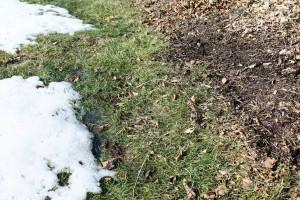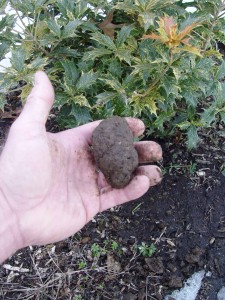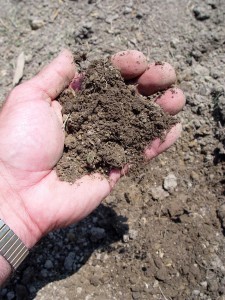Don’t Be Too Eager
March 17th, 2015
The melting of the snow, the return of sane temperatures, and the arrival of St. Patrick’s Day – the unofficial central-Pa. pea-planting milestone – has stir-crazy gardeners chomping at the bit to get out in the dirt.
Not so fast.
I know you’re antsy, but before you dig, give the ground a chance to dry out.
Even though the snow cover is gone, the moisture it left behind will take some time to drain and evaporate in most yards.
Digging in or walking on soggy soil can ruin its structure by forcing out air spaces, leaving you with compacted clods that roots struggle to penetrate – especially in clay soil.
Once you mess up the soil structure, it’s hard to fix.
This is the time when raised beds and compost-amended, well drained soil really pay off.
Those kinds of gardens dry out within days of a snow melt and also warm quicker, giving raised-bed gardeners a jump on gardeners still staring at a cold mud pit.
Of course, raised beds also dry out faster in summer, so the tradeoff is more watering then in exchange for an earlier start now.
How do you know if the soil is ready for digging and planting?
One way is the eyeball test. If you can see standing water or a glistening, glossy surface, give it some more time.
If that test checks out, try sticking a trowel in the soil. That’ll give you a feel for obvious sogginess a few inches down and may even give you a surprise in cases where the ground is still frozen just under a thawed surface.
If the trowel test checks out, dig a handful of soil and squeeze it into a ball. If water comes out or if it forms a sticky, solid clod something akin to Play-Doh, give it more time to dry.
If the soil ball crumbles readily in your fingers – or if you can’t make it stick into a ball in the first place – you’re ready to go.
Keep in mind that different parts of your yard may be ready to go before others.
A sloped section may be in good shape while a low-lying dip or a bed at the base of a slope might still be soggy.
The light exposure in different parts of the yard also makes a big difference in both soil moisture and soil temperature.
This is actually a great time to tell where your hottest, sunniest parts of the yard are, if you don’t already know.
Snow generally melts first from the most sun-drenched west- and south-facing areas. Those sections usually are warmer and drier than east- and north-facing spots and those shaded by buildings or evergreens.
That bit of feedback can help a lot at plant-selecting time. Areas where the snow melted first are likely full-sun locations that call for sun-loving, heat-tolerant species.
The curve ball is deciduous trees. Consider whether the canopy of those trees will shade an area that appears to be sunny now as indicated by an early snow melt.
Be patient. It’s been a long, cold winter that hung around long enough that we’re just going to have to accept that spring planting might be slightly delayed this year.
It’s better to wait until the weather cooperates than to try and force things and either ruin the soil or have plants be stunted by planting them in too-cold, too-wet soil.
Those warm winters spoiled us.










